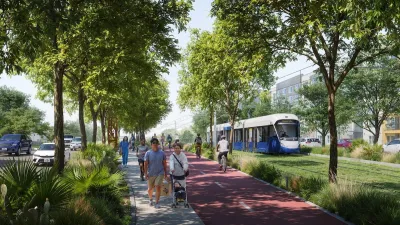Bus rapid transit has seen a recent spike in interest, and with that interest has come the analysis that BRT takes away from light rail projects and vice versa. But as this post points out, they need each other and work better when both are around.
The Transport Politic runs down recent coverage of BRT as a false argument against rail. That argument simplifies city mobility too much, according to this post.
"What is clear is that for the majority of American cities - excluding only a few in the Northeast - buses will remain the predominant mode of public transit for most riders, even after major expansions in train networks planned for cities from Charlotte to Phoenix. So even cities that choose to invest in rail projects must also spend on the improvement of their bus lines.
Nor is the difference in costs between rail lines and BRT nearly as great as some would argue. The Journal article quotes Dennis Hinebaugh, head of a transportation center at the University of South Florida, saying "You can build up to 10 BRT lines for the cost of one light-rail line." That might be true if you're comparing a train operating entirely in its own right-of-way with a bus running in a lane painted on the street. But a streetcar is probably cheaper than a busway. Just ask Hartford, whose busway project will cost $60 million a mile to build."
FULL STORY: The Silly Argument Over BRT and Rail

Study: Maui’s Plan to Convert Vacation Rentals to Long-Term Housing Could Cause Nearly $1 Billion Economic Loss
The plan would reduce visitor accommodation by 25,% resulting in 1,900 jobs lost.

North Texas Transit Leaders Tout Benefits of TOD for Growing Region
At a summit focused on transit-oriented development, policymakers discussed how North Texas’ expanded light rail system can serve as a tool for economic growth.

Using Old Oil and Gas Wells for Green Energy Storage
Penn State researchers have found that repurposing abandoned oil and gas wells for geothermal-assisted compressed-air energy storage can boost efficiency, reduce environmental risks, and support clean energy and job transitions.

Private Donations Propel Early Restoration of Palisades Playground
Los Angeles has secured over $1.3 million in private funding to restore the Pacific Palisades playground months ahead of schedule, creating a modern, accessible space that supports community healing after recent wildfires.

From Blight to Benefit: Early Results From California’s Equitable Cleanup Program
The Equitable Community Revitalization Grant (ECRG) program is reshaping brownfield redevelopment by prioritizing projects in low-income and environmental justice communities, emphasizing equity, transparency, and community benefits.

Planting Relief: Tackling Las Vegas Heat One Tree at a Time
Nevada Plants, a Las Vegas-based nonprofit, is combating the city’s extreme urban heat by giving away trees to residents in underserved neighborhoods, promoting shade, sustainability, and community health.
Urban Design for Planners 1: Software Tools
This six-course series explores essential urban design concepts using open source software and equips planners with the tools they need to participate fully in the urban design process.
Planning for Universal Design
Learn the tools for implementing Universal Design in planning regulations.
Ascent Environmental
Borough of Carlisle
Institute for Housing and Urban Development Studies (IHS)
City of Grandview
Harvard GSD Executive Education
Toledo-Lucas County Plan Commissions
Salt Lake City
NYU Wagner Graduate School of Public Service





























